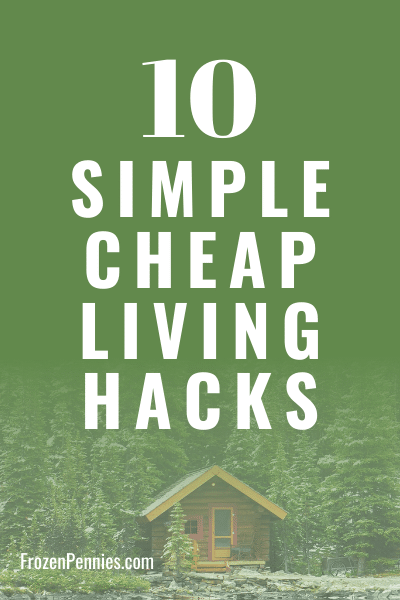Big Dreams, Small Budget: How to Live Well for Less
Whether a financial setback has hit you or you’re focused on climbing out of debt, it’s time to buckle down, get creative, and learn to live simply and cheaply. At first, it might feel overwhelming to make significant changes to your lifestyle, but with a solid plan and a fresh mindset, you can weather the storm and come out stronger on the other side.
Hard times are never easy, but they often bring clarity. When you strip life down to its essentials, you gain a renewed focus on what truly matters. You might even find unexpected peace in living simply, even if it wasn’t by choice. Let’s dive into how to create a cheap living plan, simplify your life, and embrace a mindset of frugality that will set you up for success.
Create a Cheap Living Plan
The first step is getting honest with yourself about your spending. Start by opening your banking app or pulling out your bank statements from the last three months. Yes, this part might be uncomfortable, especially if you’ve avoided your finances. But remember, knowledge is power—this exercise is about understanding where your money is going so you can take back control.
Make a list of every expense, from groceries and utilities to streaming subscriptions, takeout meals, and those impulse purchases we all fall victim to. Don’t forget recurring expenses like gym memberships, magazine subscriptions, or that automatic payment for an app you don’t even use anymore.
Once you’ve tallied it, it’s time to separate the essentials from the non-essentials. Essentials are what I like to call the “four walls”: housing, utilities, food, and transportation. These are non-negotiable because they allow you to survive and function. Everything else—even your daily latte or that “small” Amazon purchase—can be reduced, paused, or eliminated entirely.
It might initially feel extreme, but this is about focusing on your survival and stability. Once you’ve mastered living within your means, you can more thoughtfully reintroduce the things you value most.

Simplify Your Life
Living cheaply is not just about slashing expenses; it’s about simplifying your life to focus on what truly matters. Start with your debts. If you have outstanding balances, communication is your secret weapon.
Communicate
Call your credit card companies, car lenders, student loan providers, or mortgage company and explain your situation. You’ll be surprised how many organizations have hardship programs to help people during tough times.
For example, many credit card companies will allow you to defer payments or reduce interest rates temporarily if you’re upfront about your struggles. Similarly, car lenders might let you skip a few payments and add them to the end of your loan.
Mortgage companies often have forbearance or modification programs, and student loan providers offer deferments, income-driven repayment plans, or even temporary payment suspensions. The key is to reach out before you miss payments—it shows responsibility and increases your chances of getting help.
Spending Freeze
Now is also the time for a spending freeze. This means cutting out every non-essential expense. Stop ordering takeout, cancel your streaming services, and avoid online shopping. Instead, lean into free or low-cost activities. Rediscover the joy of a good book from the library, take a walk in nature, or have a family game night at home. These simple pleasures often bring more satisfaction than we realize.
Stop spending money
The time is now for a complete spending freeze. Do not spend money on anything that you do not have to spend money on.
Stop ordering from Amazon. Stop getting pizza delivery. You don’t really need any new clothes or shoes. Don’t go out unless it’s essential. Spend less money.
Learning how to live without going out to dinner, shopping for therapy, or spending too much entertaining oneself is not going to be easy.
It’s going to get extreme. A lot of people have no idea how to live without all the perks and are spending a lot of money unnecessarily.

Keep utility bills low
Utilities are a significant monthly expense, but there are plenty of ways to trim them. Start by being mindful of your usage. Turn off lights when you leave a room, unplug electronics when not in use, and adjust your thermostat to use less energy. For example, lower the heat a few degrees in colder months and layer up with cozy sweaters and blankets. Use fans instead of air conditioning in warmer months or open your windows to let in a cool breeze.
You can also save on water bills by taking shorter showers or washing only full loads of laundry and dishes. If you can access an outdoor space, consider line-drying your clothes instead of using the dryer. Even small changes, like switching to energy-efficient light bulbs or cooking meals in bulk to reduce stove use, can make a noticeable difference over time.
Every dollar saved here is something you can put toward something more essential, like food or housing.
How to live on practically nothing
Its time to cut out all unessesay spending.
Living on practically nothing might sound impossible, but it’s more achievable than you think. It’s about re-evaluating your priorities and getting creative with your resources. Start by canceling anything that isn’t absolutely necessary, such as cable, premium internet plans, and other subscriptions. Many people find they don’t miss these luxuries as much as they expected once they let them go.
Reassess your phone plan. Prepaid plans or budget carriers often provide unlimited talk, text, and data for a fraction of the cost of traditional providers. Some plans cost as little as $25 a month, which could free up significant funds.
Housing is often the biggest expense, so consider downsizing if your current situation is unsustainable. Moving into a smaller apartment, renting a room, or even exploring alternative living options like RVs or campers can dramatically reduce your costs. If you have family nearby, sharing a home temporarily could also help lighten the financial load.
Sell everything
If you’re struggling to make ends meet, selling unused items from around your home can provide some much-needed cash. Look for things you no longer use—clothes, furniture, electronics, books, toys, or even kitchen gadgets—and sell them online or at a yard sale. Embrace the minimalist mindset and keep only what truly adds value to your life.
Sell everything that you can. Put the boat up for sale on Facebook Marketplace. Sell the motorcycle, four-wheeler, snowmobile, and any other toys you have.
Go through your home and sell everything that isn’t nailed down.
Sell clothes, furniture, toys, books, do-dads, small kitchen appliances, anything you can find that you’re not using. Embrace minimalism. Here’s a great article explaining what minimalism is.
Go down to one car or sell ll the cars and use public transportation, bikes, or your feet to get where you need to go.
Cheaper housing alternatives
Housing is often the largest expense in anyone’s budget, so exploring cheaper housing alternatives could significantly ease your financial burden if your mortgage or rent feels unmanageable. While these changes might feel drastic, they can free up resources and provide breathing room during tough times.
If you own your home and your mortgage payment is too high, downsizing might be a good option. Selling your house and moving into a smaller, more affordable property can drastically reduce monthly expenses. Not only will your mortgage payment likely be lower, but smaller homes often cost less to heat, cool, maintain, and insure.
Another option is renting out part of your home. Do you have a spare bedroom, a finished basement, or a detached garage apartment? Renting to a college student, a single professional, or even a family member could bring in extra income to offset your mortgage. It might require some adjustments—like having the kids share a room—but the financial payoff could make it worthwhile.
If selling your home or renting out part of it isn’t possible, consider temporarily moving in with family or friends. Multi-generational living is becoming increasingly common and can help everyone save money by sharing expenses like rent, utilities, and groceries. It might not be a permanent solution, but it can help stabilize your finances during a tough period.
Finding a less expensive apartment or even renting a room in someone else’s home could be a viable option for renters. Check local listings, ask around in your community, and keep an open mind about creative solutions.
Another bold option is exploring alternative living arrangements. The tiny house movement has gained popularity because smaller spaces mean lower costs. Living in an RV, camper, or van might sound unconventional, but for some, it’s a cost-effective and adventurous way to live with fewer expenses. The entire online communities and YouTube channels are dedicated to this lifestyle, offering plenty of inspiration and practical advice.

Meal plan to make simple, cheap meals
Food is one area where a little planning can go a long way. Meal planning helps you stick to a budget while ensuring you and your family stay nourished. Focus on affordable staples like rice, beans, pasta, and oats, which are versatile and filling. Cooking meals in bulk and freezing leftovers can save time and money, making it easier to avoid the temptation of takeout.
If you have access to a food pantry or food bank, don’t hesitate to use it. These resources exist to support people during hard times; there’s no shame in accepting help when needed.
Another simple way to cut costs is to drink water instead of soda, juice, or other pricey beverages. If you need caffeine, tea is often cheaper than coffee, and you can brew it at home for pennies per cup.
Remember, food is essential, but eating well doesn’t have to break the bank.
Meal planning is essential to keeping food costs low. Understanding the prices while grocery shopping, sticking to a grocery list, and how to eat for less than $50 a week will benefit you in this time of simple, cheap living.
Having a good food stockpile is a great way to eat from your pantry. Foods like pasta, rice, and oatmeal are some cheap foods to eat.
Learning to make cheap meals like these will stretch the food money you do have.
Visit food pantries and food banks to supplement the food you have or will buy from the grocery stores.
Earn more money
If your income has taken a hit, finding ways to earn extra money can provide much-needed relief. Side hustles like babysitting, delivering groceries or meals, mowing lawns, or doing handyman work can be quick ways to bring in cash. If you’re comfortable online, consider freelancing, selling crafts, or tutoring to supplement your income.
Bartering is another option. If you have hair cutting, sewing, or home repairs skills, trade your services for things you need. Bartering can be a win-win for both parties and help you avoid spending money altogether.
For those feeling entrepreneurial, tough times can also be an opportunity to explore starting a small business. Many successful ventures began as side hustles during hard times, so don’t overlook the possibilities.
If you’ve been affected by job loss, there are always ways to earn more money.
Delivering pizzas, mowing lawns, babysitting, and Uber are all side hustles. It might even be the right time to start a business.
Embrace Frugal Living as a Mindset
Frugal living is more than a series of actions—it’s a mindset. It’s about seeing the value in simplicity and taking pride in your resourcefulness. Think of it as a game: How little can you spend? How much can you save? Track your progress with charts, journals, or apps, and celebrate your successes, no matter how small.
This phase of life won’t last forever. While it might feel like these changes are permanent, they’re not. By embracing frugality now, you’re laying the foundation for a more secure financial future. One day, you’ll look back on this time and see how it helped you grow stronger, smarter, and more resilient.
For now, take it one step at a time. Focus on what truly matters—your family, your health, and your basic needs. Trust that you have the strength and creativity to navigate this chapter of your life. Hard times don’t last forever, but the lessons you learn during them can last a lifetime.
If you decide to live on only what you need and change your mindset, simple, cheap living will be less stressful and much more fun.
Think of it as a game. Use pictures and printable trackers to see how much money you are not spending.
None of this is easy. When faced with a sudden loss of income, big changes need to happen, and it’s not human nature to embrace change.
Give yourself a few minutes to understand the task at hand and accept that nothing will be the same tomorrow as it was yesterday.
It’s all about learning to live cheaply once this chapter is over. It may or may not be a long time, but it will not be forever. The situation is not long-term.
There will be a day when you can buy another motorcycle or boat. But right now, you must learn how to be cheap and live frugally.




